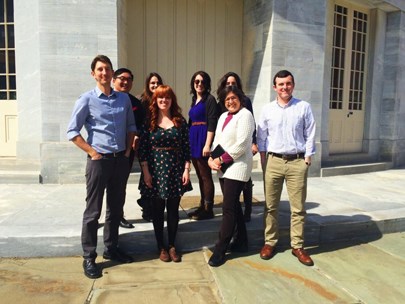
NPS PHOTO A Reflection on a Career with the NPS
On my birthday, I found out that I was accepted to participate in 2015's Park Break fellowship. It was quite the birthday present considering what a valuable and prestigious opportunity the program presents. Park Break is an all-expenses-paid, park-based seminar available to graduate students who are interested in careers in park management, park-related research, and education. It is organized by the National Park Service (NPS) and the George Wright Society (GWS). The GWS is the professional association for researchers, resource managers, administrators, and educators who work in or on behalf of parks, protected areas, and cultural sites. I have been working with the NPS for the past year at Klondike Gold Rush National Historical Park (KLSE) on a program called "In My Backyard" (IMBY). The mission of IMBY is to connect youth with community, cultural, and natural resources. Although I've been working with the NPS, this opportunity was valuable because it allowed me to gain experience in another national park and learn more about the agency. I heard about this fellowship opportunity from the Operations Manager of my Master's program and was further encouraged to apply by Ranger Kelsey Johnson at KLSE.
I was accepted to the cultural resources session that was hosted by Independence National Historical Park (INDE) in Philadelphia. I was one of eight graduate students accepted nationally to participate. It was an intensive five day fellowship in which we designed an exhibit that incorporated the archaeology of the site. Our exhibit was designed to answer the following research questions:
1.What information do archeological investigations at New Hall yield about the U.S. War Department? 2.How can we incorporate the collections into our exhibitions there? In addition to designing the exhibit, we met with park employees to learn more about their involvement and history with the NPS. We also went on tours to learn about New Hall and how similar sites have been interpreted throughout the park.

The purpose of our exhibit is to utilize the archaeology, architectural changes, and historical personalities to interpret New Hall in the context of the development of the US military as well as the city of Philadelphia. The exhibit combines archeological artifacts, historic photographs, and text panels to tell the story of New Hall. The main feature of the exhibit is a stratigraphic timeline that highlights significant periods throughout the history of New Hall. Our team chose to use this type of timeline to tell the greater story of the War Department, the history of the building, and events taking place in Philadelphia. To create this component, a mural of the excavation profile of the Carpenters' Court privy will be placed on the center of the wall. This component was chosen because a majority of the artifacts used in this exhibit were found during the excavation of the Carpenter's Court Privy. 
To be more efficient, we divided into teams based on our strengths. This all happened quite organically and worked very well. Mikaela Maria and Joana Arruda researched the building and its occupants, wrote the text panels, and effectively created our storyline. Kevin Kim and Jim Kopaczewski searched for specific objects and found photographs for the exhibit while writing and designing a panel adjacent to our exhibit space that elaborated the story of New Hall as a military industrial complex. Chris Binder, Merilee Atkinson, and I chose specific objects to integrate the storyline and focused on the design of our exhibit space. Some objects included were cannon balls to portray the military history of New Hall as the War Department and a shaving cream pot to highlight the variety of businesses that utilized the space. Mary Furlong Minkoff taught us all about archaeology, compiled the exhibit plan document, and maintained continuity among the groups to ensure a cohesive exhibit.

I would like to thank all the people at the GWS and INDE that made this year's session possible. In addition to the ones mentioned in this reflection, many thanks go to Lucas Westcott, Chris Higgins, Renee Albertoli, Bethanne Wilson, Nicole Altmann, and everyone else that took the time to meet with us throughout the week. Thank you!
|
Last updated: January 5, 2024
